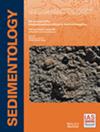粒度过渡对沉积物供应和水排放的化石自生反应:冲积扇实验
IF 2.8
2区 地球科学
Q1 GEOLOGY
引用次数: 0
摘要
自生反馈作用可在冲积扇中产生大规模、有组织的地层模式,但要解释特定上游边界条件的自生沉积特征仍具有挑战性。本文结合理论、实验和实地应用,探讨如何将自生岩性变化解释为上游边界条件的地层指标。研究人员进行了六次实验,以测试在具有两种主要粒度的冲积扇中,沉积物供应量和排水量对岩性边界(粒度过渡)自生进退的影响。粒度过渡带的迁移导致在倾角方向的沉积断面上粒度过渡带位置出现短期的之字形模式。在每个实验中,都使用了扇面表面的延时图像和激光地形扫描图以及最终沉积物的地层断面图来量化自生过程的特征时间尺度。随着沉积物供给率的增加和排水率的降低,扇缘迁移、地表湿分变化和粒度过渡迁移的时间尺度通常会缩短。提高泥沙供应率会缩短河道泥沙储存和释放周期的持续时间,从而在粒径过渡轨迹中产生更高频率的 "之 "字形变化。增加排水量往往会拓宽河道,延长河道泥沙储存和释放周期的持续时间,在粒径过渡轨迹中形成频率较低的之字形。增加排水量还能使更多泥沙在释放过程中进一步向下游输送,从而在粒径过渡轨迹中形成更高的 "之 "字形。上游边界条件与粒度变化轨迹之间的这些关系表明,自生地层信号可用作推断边界条件相对变化的工具。本文章由计算机程序翻译,如有差异,请以英文原文为准。
Fossilized autogenic responses of grain-size transition to sediment supply and water discharge: Alluvial fan experiments
Autogenic feedbacks can produce large-scale, organized stratigraphic patterns in alluvial fans, but autogenic depositional signatures of specific upstream boundary conditions remain challenging to interpret. Here, a combination of theory, experiment and field application is used to explore how autogenic lithofacies changes can be interpreted as stratigraphic indicators of upstream boundary conditions. Six experiments were conducted to test the effects of sediment supply and water discharge rates on autogenic advance and retreat of the lithofacies boundary (grain-size transition) in an alluvial fan with two dominant grain sizes. Migration of the grain-size transition caused a short-term zigzag pattern in the grain-size transition position in the dip-directional deposit section. For each experiment, time-lapse images and laser topographic scans of the fan surface and stratigraphic cross-sections of the final deposits were used to quantify characteristic timescales of autogenic processes. Timescales for fan-margin migration, surface wet-fraction change and grain-size transition migration generally shorten as sediment supply rate increases and water discharge rate decreases. Increasing the sediment supply rate shortens the duration of the fluvial sediment storage and release cycle, producing higher frequency zigzags in the grain-size transition trajectory. Increasing the water discharge tends to widen channels and lengthens the duration of the fluvial sediment storage and release cycle, constructing lower frequency zigzags in the grain-size transition trajectory. Increasing the water discharge also enables more sediment to transport further downstream during release events, leading to higher magnitude zigzags in the grain-size transition trajectory. These relationships between upstream boundary conditions and the grain-size transition trajectory demonstrate how autogenic stratigraphic signals could be used as a tool to infer relative changes in boundary conditions.
求助全文
通过发布文献求助,成功后即可免费获取论文全文。
去求助
来源期刊

Sedimentology
地学-地质学
CiteScore
8.20
自引率
11.40%
发文量
94
审稿时长
6-12 weeks
期刊介绍:
The international leader in its field, Sedimentology publishes ground-breaking research from across the spectrum of sedimentology, sedimentary geology and sedimentary geochemistry.
Areas covered include: experimental and theoretical grain transport; sediment fluxes; modern and ancient sedimentary environments; sequence stratigraphy sediment-organism interaction; palaeosoils; diagenesis; stable isotope geochemistry; environmental sedimentology
 求助内容:
求助内容: 应助结果提醒方式:
应助结果提醒方式:


